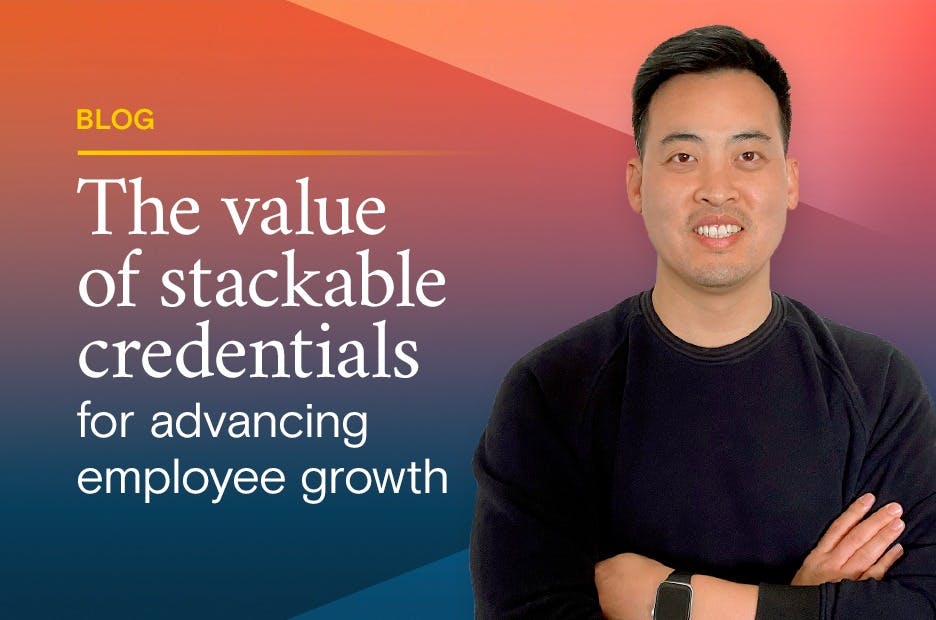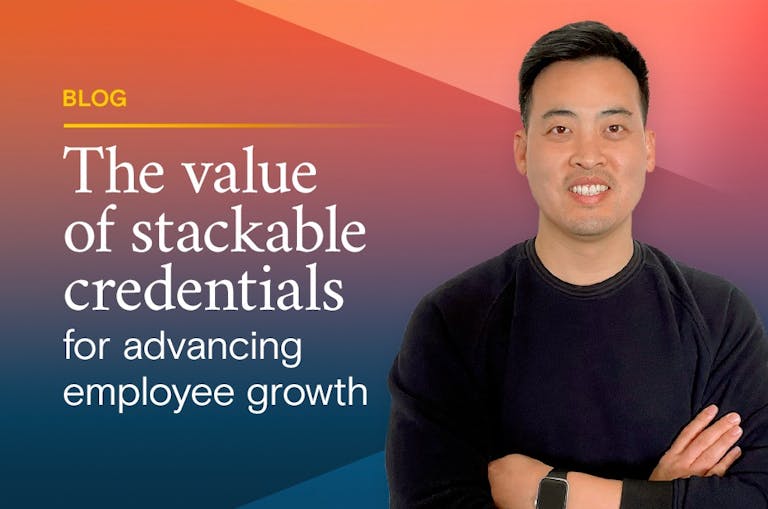A Q&A with Eugene So, Director of Academic Programs and Pathways at InStride, where he discusses the value of stackable credentials.
An exciting trend in workforce education is the rise of stackable credentials. Available in various forms, stackable credentials have recently taken a greater sense of importance amid the global pandemic and subsequent economic fallout.
Eugene So, Director of Academic Programs and Pathways at InStride, provides insights about this trend. He also breaks down the components every L&D leader should know — how stackable credentials are especially beneficial for working adults and contribute to a company’s immediate needs, while setting the stage for continuous, long-term success.
What are stackable credentials?
In both the academic and professional sense of the term, stackable credentials refer to the bundling of learning options that help to build upon a learner’s overarching skills and competencies.
In other words, a stackable credential can be viewed as an individual short-form course or certificate that builds towards a larger, long-term credential (such as a degree.) Students can “stack” multiple credentials over a set period of time to work towards a degree, or expand their skill set for career advancement.
Why are stackable credentials becoming so popular?
As higher education continues to evolve, we’re seeing a rise in the creation of more stackable certificate programs due to the unique value they offer to working adult learners.
Undertaking shorter-form courses and certificates enable adult learners to acquire valuable, portable skills, accrue an appetite for learning and build confidence while working towards aspirational goals.
These certificates provide highly relevant, skill-building credentials as standalone programs. Additionally, the credits earned through certificates can often be counted towards a degree – an important personal and professional milestone that has transformative value.
Another attractive element of stackable credentials is the flexibility they provide to learners in regards to pricing, time and overall commitment. For adult learners, there can be numerous challenges around pursuing a degree program. Many have been out of traditional education for some time and/or have personal and professional obligations that require around-the-clock responsibilities. Paying tuition for a full-degree program may also be risky considering life factors and possible debt obligations.
Are there different types of stackable credentials? If so, what are they?
In many ways, stackable credentials aren’t a new concept considering the history and widespread practice of transferable credits from one higher education institution to another.
However, we are definitely seeing a recent proliferation of various forms of stackable credentials. These are more nuanced and cross-functional with greater collaboration between industry and higher education institutions.
Ways stackable credentials are changing include:
- Broadening acceptance – The rise in the assessment of credit-for-prior-learning as well as acceptance of a variety of industry-required certifications for credit at many higher-education institutions.
- Influencing more industries – More traction of the “stacking” concept taking hold in industries such as IT, Engineering, Healthcare and Business.
- Widening range – Increased interest in earning digital badges, plus skills and competency mapping services for “soft-skills” such as leadership and team building.
What are some examples of academic institutions that offer stackable credentials?
The City of New York University (CUNY) School of Professional Studies provides a great deal of innovation around stackable credentials. The organization has a robust credit-for-prior learning assessment and it offers advanced stackable certificates in areas of Management and Healthcare.
The University of Wisconsin-Madison also offers advanced certificates that account for data skills-acquisition for learners with Liberal Arts backgrounds. The Data Analytics for Decision-making Capstone was created specifically for working adults and grants nine credits that can be counted towards a master's of science degree in Information at the university.
This is just to name a few.
How are stackable credentials beneficial to businesses offering workforce education?
The value stackable credentials provide can be summed up in two words — high impact. A powerful addition to workforce development strategies, stackable credentials deliver skill-building that is:
- Flexible and customizable – Stackable credentials take into account employees’ diverse backgrounds and needs. This nurtures more workforce-ready employees equipped to enable company growth.
- Relevant – Skills acquisition is top of mind for both adult learners and corporations alike. For example, frontline workforce populations benefit from learning skills in areas that provide on-ramps for career advancement, so the ability to earn credentials in the focus areas of digital literacy and communication will tie directly into their current flow of work.
- Accessible – The ability to bundle credentials and other individual short-form courses together into a customizable manner makes it easier to access high-quality education, bolstering equal opportunity for social and economic advancements for all.
- Both immediate and future proof – Stackable credentials allow learners to gain valuable skills that would be immediately additive to the work they’re currently engaged in and contribute more to an organization’s success while paving the way for further learning down the line.
Every employee learner has a unique journey and needs a workforce education solution that’s tailored to fit his or her specific career path. In today’s environment, stackable credentials help fill this requirement. They are a key component to the equation of a flexible, modern and effective approach to employee learning.
Interested in more insights and best practices? Download our report, What to know about the workforce education journey.

